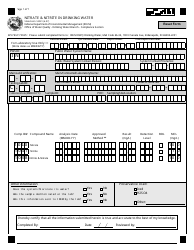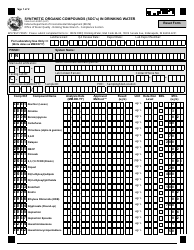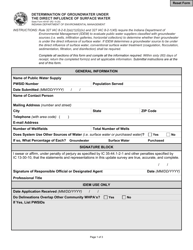State Form 53288 Trihalomethanes (Tthm) and Haloacetic Acids (Haa5) Analyses in Drinking Water - Indiana
What Is State Form 53288?
This is a legal form that was released by the Indiana Department of Environmental Management - a government authority operating within Indiana. As of today, no separate filing guidelines for the form are provided by the issuing department.
FAQ
Q: What is the purpose of State Form 53288?
A: State Form 53288 is used for Trihalomethanes (TTHM) and Haloacetic Acids (HAA5) analyses in drinking water in Indiana.
Q: What are Trihalomethanes (TTHM)?
A: Trihalomethanes (TTHM) are chemical compounds that can form in drinking water when disinfectants react with organic materials present in the water.
Q: What are Haloacetic Acids (HAA5)?
A: Haloacetic Acids (HAA5) are a group of chemical compounds that can also form in drinking water when disinfectants react with organic materials present in the water.
Q: Why are Trihalomethanes (TTHM) and Haloacetic Acids (HAA5) analyzed in drinking water?
A: Trihalomethanes (TTHM) and Haloacetic Acids (HAA5) are analyzed in drinking water to ensure compliance with regulatory standards and to assess the potential health risks associated with their presence.
Q: Who needs to submit State Form 53288?
A: Water system operators in Indiana who are required to monitor and analyze Trihalomethanes (TTHM) and Haloacetic Acids (HAA5) in their drinking water supply need to submit State Form 53288.
Q: Are there any specific guidelines or regulations for Trihalomethanes (TTHM) and Haloacetic Acids (HAA5) in drinking water in Indiana?
A: Yes, the Indiana Department of Environmental Management (IDEM) has specific guidelines and regulations for Trihalomethanes (TTHM) and Haloacetic AcidsHAA5) in drinking water, which water system operators must follow.
Q: What are the health risks associated with Trihalomethanes (TTHM) and Haloacetic Acids (HAA5) in drinking water?
A: Trihalomethanes (TTHM) and Haloacetic Acids (HAA5) have been associated with an increased risk of bladder cancer, reproductive problems, and other potential health effects.
Q: How often should Trihalomethanes (TTHM) and Haloacetic Acids (HAA5) be analyzed in drinking water?
A: The frequency of analysis for Trihalomethanes (TTHM) and Haloacetic Acids (HAA5) in drinking water depends on the size of the water system and the level of disinfection used, as specified by the regulatory guidelines.
Q: Is there a limit for Trihalomethanes (TTHM) and Haloacetic Acids (HAA5) in drinking water in Indiana?
A: Yes, the Indiana Department of Environmental Management (IDEM) has set maximum contaminant levels for Trihalomethanes (TTHM) and Haloacetic Acids (HAA5) in drinking water, which water system operators must comply with.
Q: How can water system operators reduce Trihalomethanes (TTHM) and Haloacetic Acids (HAA5) in drinking water?
A: Water system operators can reduce Trihalomethanes (TTHM) and Haloacetic Acids (HAA5) in drinking water by optimizing disinfection practices, using alternative disinfectants, or implementing treatment techniques such as carbon filtration or air stripping.
Form Details:
- Released on June 1, 2007;
- The latest edition provided by the Indiana Department of Environmental Management;
- Easy to use and ready to print;
- Quick to customize;
- Compatible with most PDF-viewing applications;
- Fill out the form in our online filing application.
Download a fillable version of State Form 53288 by clicking the link below or browse more documents and templates provided by the Indiana Department of Environmental Management.

















